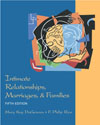Selecting a mate is one of the most important decisions individuals make,
for it can result in personal happiness and fulfillment or misery. Mate selection
in the United States is an individual decision, yet is influenced by many factors.
Four groups of theories explain the process: psychodynamic, needs, exchange,
and developmental process theories. Factors found to be important include family
background, socioeconomic status, education, intelligence, race, religious affiliation,
and age differences. Americans tend to practice homogamy in selecting a mate,
as well as to follow the practice of the marriage gradient. Marital compatibility
can be influenced by similarities in individual traits and behaviors, attitudes
and values, gender-role expectations, and personal habits. People can and do
regret their choice of mate. Nonmarital cohabitation has increased in popularity. Reasons for cohabitation
vary; it may be a utilitarian arrangement, a trial marriage, a prelude to marriage,
or an alternative to marriage. The majority of cohabiting couples have no regrets,
even though cohabitation is associated with marital instability over the long
term. Many couples prepare for marriage by receiving marital education, assessment,
or counseling. Legal requirements must also be satisfied. A number of rites
of passage mark the transition to marriage. |



 2002 McGraw-Hill Higher Education
2002 McGraw-Hill Higher Education